What is Route Optimization?
In simple terms, route optimization (RO) refers to the process of finding the quickest and most cost-effective route between any two points on the earth. However, there’s more to it than just route planning or finding the shortest route between A and B. The best routes for a business usually depend on a lot of different factors – where the customers are located, when they want to be serviced, traffic and road conditions at any given time, or which driver or vehicle is needed to do the job.
Why use Route Optimization (RO) for logistics?
It’s not quite that simple to find the shortest distance between two locations on earth because as the number of touchpoints increases, the number of possible ways to travel between them grows exponentially.
The below infographic shows the magnitude of the problem:
The grains in 1 kg of sand
Atoms in 20 grains of sand. Also, grains of sand of Earth, including deserts
Atoms in the known universe
Replace each atom in our Universe with a universe the size of ours. The number of atoms in all those universes put together is approximately this number.
With just nine locations to visit, the number of possible ways of traveling equals the grains in 1 kg of sand. When you increase the number of locations to 22, the possibility of routes increases to the number of grains of sand in the entire universe. Take the number of stops to 102 and the possibilities of the ways to travel become incomprehensible.
Globally, the route optimization software market is expected to witness growth at a CAGR of 10.9% over the forecast period of 2020-2025. Delivery route optimization helps drivers to complete day-to-day tasks in less time and eliminates manual delivery route planning with automated multi-stop route planning ability. Such software makes it possible for fleet route optimization as it can optimize the routes for several drivers simultaneously.
The business case for route optimization
Enterprises today are catering to customers with steep demands. This includes providing world-class products at reasonable prices, and a top-quality experience. For businesses that deliver products and services to doorsteps, a large part of this experience involves making speedy deliveries on time. Because research from McKinsey shows that more than half of omnichannel consumers are willing to switch brands if their delivery timelines are too long.
On the other end, the pressure on companies is two-fold: Meet the steep demands of customers while keeping costs in check, and productivity levels high. Or lose them to the competition.
The one place with the most potential to accomplish both? The all-mile, given that these deliveries form more than 53% of shipping costs. This is why supply chains need technology to automate logistics activities from end-to-end in order to save time, improve efficiencies and reduce human dependency.
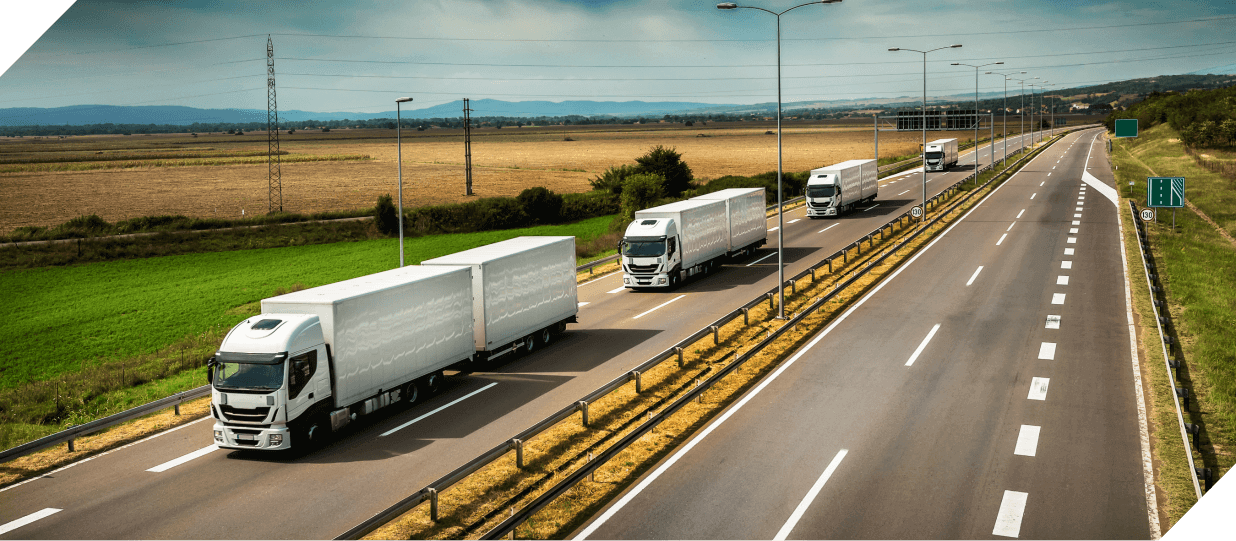
To that end, route optimization is the method of using Artificial Intelligence to figure out the quickest and most efficient route to all your stops and destinations. By testing multiple ‘what-if’ scenarios, a route optimization engine gives various route options by taking the costs involved, the resources available, historical data, and real-life road constraints into account. It allows you to cut down on operating costs, save time, and improve workforce productivity.
Using advanced route optimization software also helps in streamlining delivery processes and optimizing on-ground operations, including shipment, transportation, all-mile delivery, and reverse logistics.
With proper route optimization tools, your business could save up to 20% in mileage and improve your order capacity by as much as 100% without increasing your fleet.
To get an in-depth understanding of Route Optimization and how it can help you optimize your logistics
Route optimization constraints
Here is the list of constraints your route optimization solution should consider:
Real-time traffic
A route optimization software should ideally consider real-time traffic conditions to save your logistics costs, ensure on-time delivery and better adherence to key SLAs for increasing customer delight.
Historical data inspection
Route optimization software should also examine historical data on three levels: riders, customers and time of the day.
Data inspection
Inspecting historical data to offer logistics insights for better decision making
Fleet constraints
Often, software tends to focus on cold, hard data and ignore real-life order-vehicle constraints. For instance, different categories of products such as electronics and perishables cannot be shipped together. Sometimes, a specific kind of product, say medicines, can only be dispatched in a special fleet. An ideal RO software considers these constraints and has a better chance of helping businesses in real-world scenarios.
Importance of geocoding
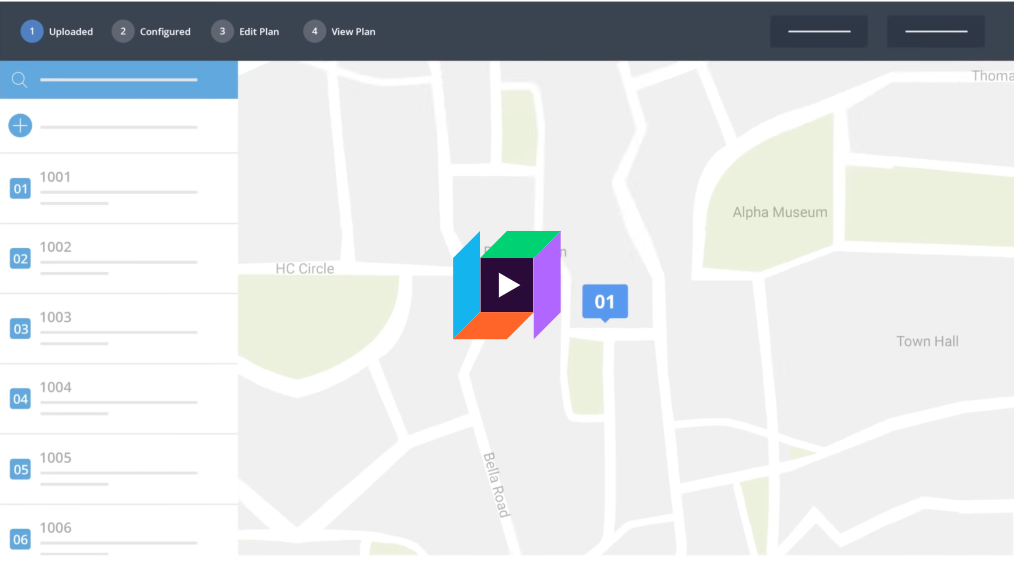
Geocoding, in layman’s terms, is the process of converting raw input data such as names of buildings, landmarks, and complex addresses into precise latitude/longitude coordinates on a map.
Locus’ proprietary geocoding engine distills and converts even the most ambiguous addresses into precise geographic coordinates that can be easily identified on a map. Powered by Artificial Intelligence and Machine Learning algorithms, the geocoding engine is capable of distilling the most useful parts of the address and creating a geocode that represents each individual address correctly on the map.
Simple route planning
Some businesses simply assign a certain number of jobs to a rider, usually based on geography, or customer visit frequency, and need software that can figure out a route for that rider to finish their assigned work.
This kind of route planning software, i.e navigation and turn-by-turn directions, has been traditionally used by companies. The basic form of simple route planning is built into almost every digital device that has a global positioning system (GPS)-based navigation system.
However, it lacks the ability to interact with on-ground restrictions and real-time traffic conditions to suggest the shortest journey from a time or mileage perspective.
Scheduled route optimization
Scheduled Route Optimization on the other hand has the ability to accept operational dynamism and complex business constraints to determine an optimized route.
Scheduled route optimization software accepts daily planning-related data, not limited to order details, location details, fleet details, volumetric data, etc. along with operational constraints such as workload balance, rider preferences, tribal knowledge and skills, etc. to suggest the most efficient way to successfully execute the deliveries.
Gain better ROI from your business
What to look out for in route planning software?
Autonomous route planning
AI-driven route planning that can reduce errors caused by human negligence and minimize human intervention
Accurate geocoding
Advanced geocoding abilities that can convert fuzzy addresses into precise geographic coordinates on the map
Intelligent vehicle allocation
Smart vehicle allocation based on traffic, shipment, vehicle type, etc.
Cost-based route optimization
Consideration of multiple cost variants to offer the most economical route
Optimal fleet mix
Offering a best-fitting fleet mix based on consumer preferences
First attempt delivery
First attempt delivery is ensuring deliveries in the first time around, saving you storage and re-delivery costs.
Single route plan
Intelligent forward and reverse logistics in a single route plan by clubbing returns along with regular deliveries
Automated escalation
Notifying authorities in case of route divergence or contingencies
Historical data inspection
Analyzing historical data such as riders’ tribal knowledge, delivery preferences, customers’ preferred time slots, etc. to plan routes effectively
Rider preferences
Taking into account rider skills, expertise, and preferences for a smooth transition from traditional routing to AI-based route planning platform
Powerful route automation for the smart business
What is real-time dynamic routing software?
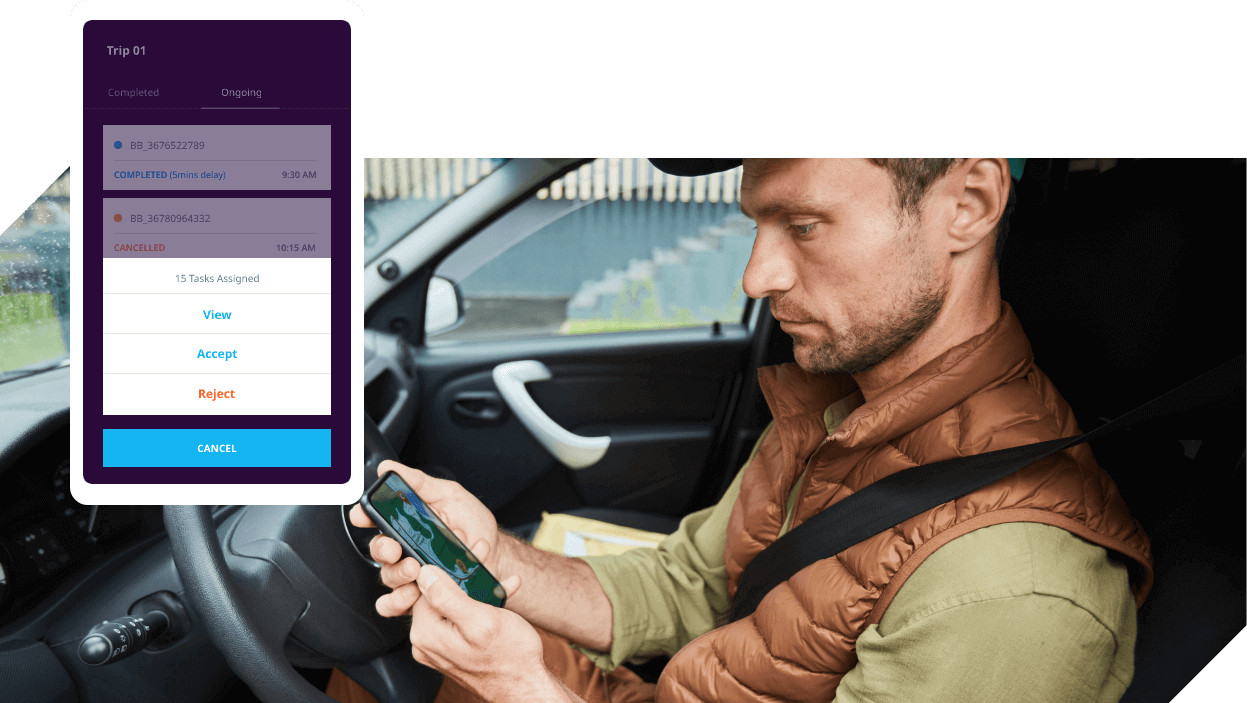
Real-time dynamic routing software optimally handles on-demand orders alongside scheduled orders. In case the orders/preferences of the customers change while the rider is out to deliver, it can change and create new routes for the rider instantly.
With routing requirements of companies becoming more complex, it is of prime importance that companies choose vehicle routing solutions that operate in real-time, that can help plan routes intelligently to improve delivery efficiency, and reduce costs.
Better results with better routes
How route optimization helps solve the all-mile problem

All-Mile delivery is the end-point in the supply chain, and perhaps the most important one, because this is the point where the customer and your brand interact in person. Customer experience is therefore a top priority for businesses in the supply chain, above and beyond cutting down logistics costs and improving productivity in operations.
Route Optimization helps in improving this all-mile experience and solves two of the most challenging logistical problems: the Traveling Salesman Problem (TSP) and the Vehicle Routing Problem (VRP).
However, many RO solutions don’t consider on-ground restrictions and lack the knowledge of regional elements. Advanced RO solutions follow global standards in terms of performance while incorporating local constraints, and help companies in creating a differentiating factor for their customers.
All-mile delivery: challenges and solutions
Fleet route optimization can help in improving all-mile delivery operations and cutting down logistics costs in the following ways:
Best-fitting fleet mix recommendations
Delivery Orchestration considers the business as well as ground restrictions such as traffic, complex geographies, etc.
Smart clubbing of orders
based on factors such as preferred delivery time slots, priority orders, location preference, and order specifications
Predictable and convenient time windows of delivery
for customers thereby increasing first attempt rates and higher customer experience
Electronic Proof of Delivery (EPOD)
for reducing friction with customers and digitization of all-mile delivery processes
Enable multiple stops on routes
Which improves workforce productivity, curbs labor costs and minimizes human dependency.
Smart and easy-to-use mobile application
for logistics managers to monitor logistics operations, send predictive alerts on delays, vehicle breakdowns, idle time, live tracking, etc to improve both customer experience and efficiency of delivery executives
Geocoding and accurate address detection
for automated sorting processes
Reduced turnaround time for the customer
by optimizing first-mile operations, sharing locations of warehouses/distribution centers in real-time, reducing sorting times at fulfillment centers and all-mile distribution centers
Locus’ vehicle routing & scheduling engine
Locus Dispatch Management Platform (DMP) enables organizations to drive real-world efficiency across all fulfillment channels, be it improved SLA adherence, resource utilization, and unit economics across most major fleet types.
The platform’s AI-based RO solution, the Vehicle Routing and Scheduling Engine, provides supply chain enterprises with an automated route planning and optimization solution that considers multiple real-life constraints and distribution models. It is a comprehensive solution in logistics that enhances fulfillment operations and increases consistency in transport planning, with nearly no human intervention. The cloud-based tool also facilitates GPS tracking for monitoring vehicles and providing clients with accurate and real-time ETAs.
The engine optimizes delivery routes based on three different metrics - geography, time and vehicle, offering a single screen view of the distribution plans. It considers real-life constraints and distribution models to offer the shortest possible and most effective delivery routes, ensuring optimization across freight costs, time on-road, distance on-road, and compliance with SLAs.
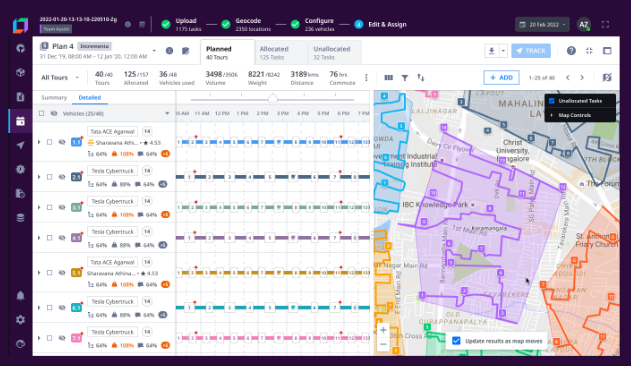
What are the benefits of an online route optimization tool?
-
Speedy return on investment (ROI)
-
Investing in RO is one of the best financial decisions a company can take. Even though the solution can cost a little money in the beginning, the immediate savings on fuel and labor costs usually result in the route planning software paying for itself within the first month of purchase.
-
Reduced fuel costs
-
Industry research confirms that the fuel spend is usually 60% of the fleet's operating expenses. An optimum route will mean less distance covered and thus, less fuel required. Also, better vehicle utilization means less number of vehicles required which results in saving fuel costs.
-
Reduced labor costs
-
With Locus’ route planning software providing the most efficient routes for operations, industries can count on their work getting wrapped up quicker than before. This means no overtime costs for staff and less requirement of manual labor.
-
More productivity
-
With automated and optimized routes, it is possible to add that extra stop, make that additional delivery or receive one more return from the customer. This improved productivity translates into better overall revenue and directly impacts the bottom line.
-
Data-driven recommendations
-
The Vechicle Routing & Scheduling Engine allows you to allocate orders based on historical data, priority, rider skills, and on-ground constraints such as traffic. Optionally, Locus also takes rider preferences into consideration when routing jobs to them.
-
Territory-based route planning
-
This feature allows logistics managers to plan delivery routes not just dynamically, but also based on territories and zonal specifications. Territory-based route planning eliminates the problem of multiple riders going to the same vicinity, and makes it easy for logistics planners to allocate orders to particular riders who know the vicinity well.
-
Real-time tracking
-
Using the live tracking feature and predictive alerts, you can monitor drivers and compare their actual route to the planned route if drivers go off track. Managers can re-route drivers in real-time and benefit from dynamic ETA calculations. Customers can also track their delivery status with live updates.
-
Lesser carbon emissions
-
The use of the Vehicle Routing & Scheduling Engine results in lesser miles driven, less number of vehicles used and reduced fuel consumption. All of this results in lower carbon emissions and less pollution for the environment.
-
Improved customer experience
-
Locus’ RO helps immensely in increasing the efficiency of the all-mile delivery. Servicing customers at the choice of their time means an increase in customer delight.
-
Increased transparency, efficiency, and consistency in operations
-
Automated decision-making in operations for a flawless workflow and reduces the scope for human error.
Impact of route optimization across different business sectors
Enterprises across different sectors need RO to serve different purposes. The retail industry is trying to fight the e-commerce players by having an omnichannel presence. On the contrary, the e-commerce sector is struggling with increasing customer expectations with respect to deliveries. There are a number of industries in the supply chain such as retail, 3PL, FMCG and home services that still rely on manual, time-consuming logistics processes. Many logistics activities involve human decision making, the processes are time-taking and prone to human errors and there is clearly a lack of visibility of logistics across these sectors.
With route planning software providing the most efficient routes for operations, industries can count on their work getting wrapped up quicker than before. This means no overtime costs for staff and less requirement for manual labor.

Route optimization in retail
-
RO software considers 18+ cost variables and multiple real-life constraints, and offers the shortest and most cost-effective routes, thereby cutting down fuel and labor costs significantly.
-
Automated decision making in operations for a flawless work-flow and reduced scope of human errors, thereby increasing productivity and consistency in logistics operations.
-
Complete omnichannel fulfilment with scheduled and on-demand routing, real-time customer interaction and efficient fleet utilization.
-
RO software helps in reducing the miles driven, number of vehicles used and limited fuel consumption, resulting in lower carbon emission and less pollution.
-
Increased efficiency of all-mile delivery and servicing customers at the choice of their time, improves customer satisfaction and loyalty for the brand.

Route optimization in FMCG/CPG industry
-
RO can automate the dispatch process respecting real-life constraints to bring in efficiency, transparency, and consistency in fulfillment operations
-
Route Optimization allows FMCG businesses to scale from an existing retail infrastructure to an omnichannel distribution platform and offer same day doorstep deliveries to the customers
-
It enables in controlling business constraints around SKU bifurcation, outlet timings, regulatory constraints etc. for the dynamic dispatch planning
-
Recommends optimal fleet mix to choose (one-time & daily dynamic) for efficient fulfillment
-
Intelligent ranking of salesmen on skills, experience, familiarity, and preference for a locality or region.
-
Automated sales beat plans to ensure less on-road time and more in-store time spent by sales representatives to increase sales.

Route optimization in 3PL
-
Geocoding and locality detection to automate shipment sorting processes inside delivery centers
-
Automated fulfillment operations and reduced secondary freight costs, for 3PL service providers and distributors.
-
Traffic prediction, road constraints, outlet timing for unloading, etc. considered for optimal daily dynamic route planning for 3PL fulfillment.
-
Real-time fleet tracking, ideal and executed route comparison and instant alert on delays to help with more visibility of the fleet.
-
Reduced dispatch planning time and easy accommodation of unplanned on-demand orders on the go.

Route optimization in e-commerce
-
Geocoding and locality detection to automate shipment sorting processes inside delivery centers
-
Optimized routes and automatic allocation to riders based on historical data and dynamic planning.
-
Improved vehicle utilization and balanced number of deliveries per driver to accommodate breaks in the schedule.
-
End-to-end visibility of all vehicles, riders and other on-ground resources in a unified dashboard.
-
Servicing when customers want by setting delivery windows and lesser number of failed deliveries leading to SLA adherence and better customer delight.

Route optimization in home services
-
Analysis of historical data to understand traffic conditions, preferred service timings of customers and opening/closing hours of specific buildings
-
Overseeing operations on a single dashboard to get smart status alerts for delays, idle time, spillage, etc
-
Monitoring vehicles and tasks assigned on a single day and sharing real-time status updates with clients
How route optimization can help different business segments?
Resources
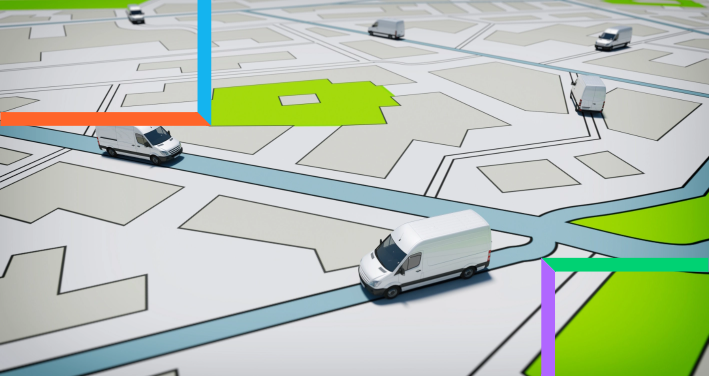
Blog
Multi-stop route planning and why is it important?
Planning multiple routes manually is a burdensome and time-consuming affair. Fleet managers should factor in various route constraints while planning routes such as traffic congestion, roadblocks, and so on. There are likely chances of making mistakes, which can ultimately result in disappointed customers.
Read moreRoute Optimization is the need of the hour to improve logistics performance, streamline all-mile operations and stay ahead in the supply chain landscape. Get started with your logistics optimization journey now.
Get in touch with our experts for a quick tour of our solutions.



